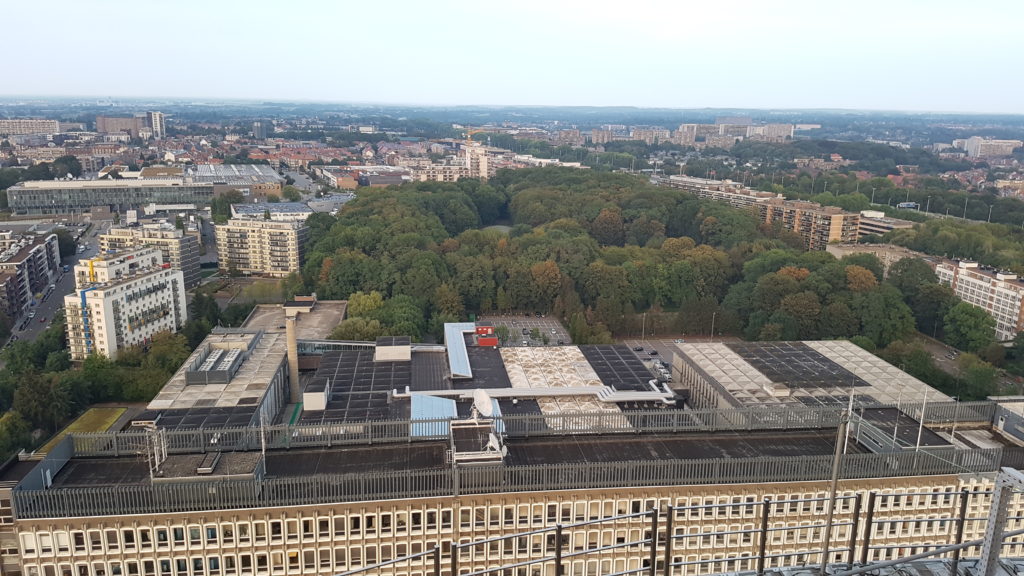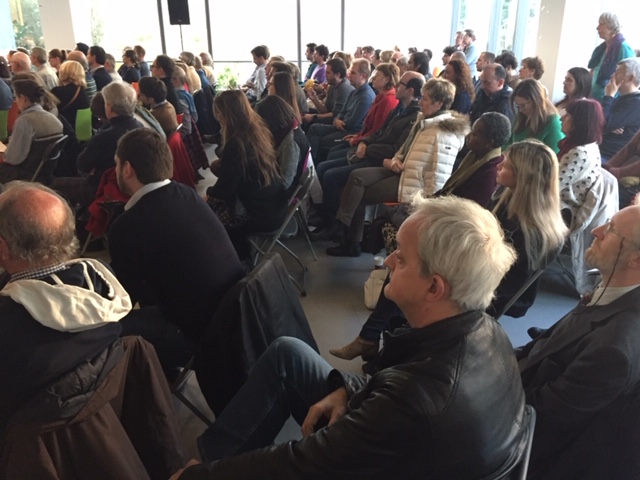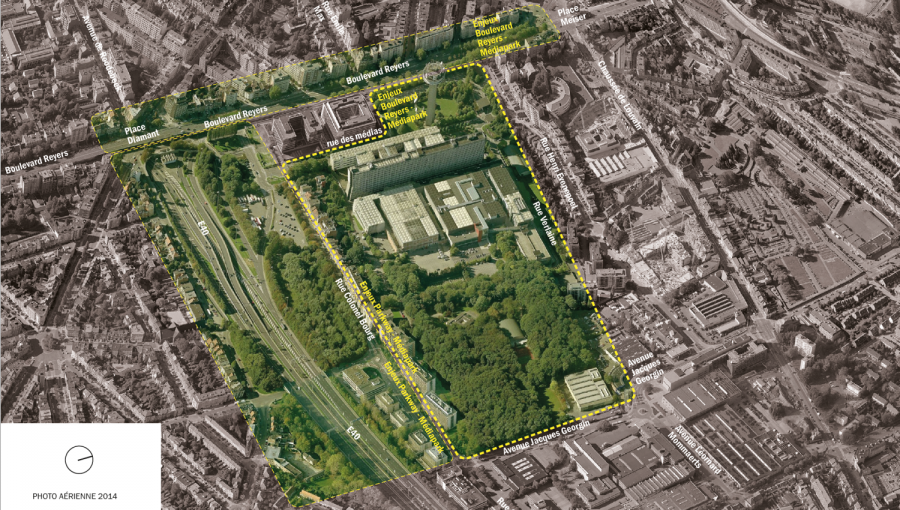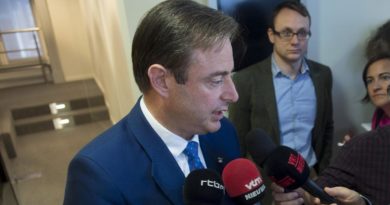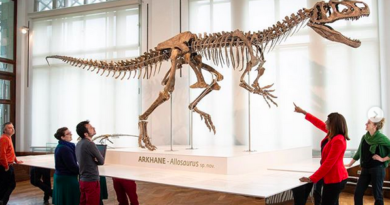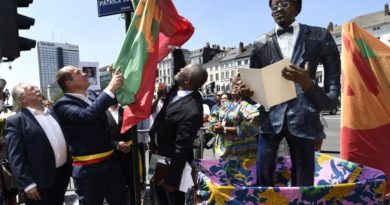Brussels Region’s plan for a new Mediapark is triggering strong reactions among citizens
Located in the municipality of Schaerbeek, the Tir National (the National Shooting Range) was a wetland of fields and meadows until the 19th century. In 1889, Victor Besme created a vast military complex there, including an imposing building and some ten hectares of land for artillery exercises and shooting practice.
At the edge of this Shooting Range, the “Enclos des Fusillés”, a small, little-known cemetery, contains the graves of 365 resistance members from the two World Wars, including Edith Cavell.
The National Broadcasting Institute (INR-NIR), created in 1930 and based originally in Rue du Bastion, in 1939 moved to the “Maison de la Radio”, Place Flagey. Subsequently, lacking space in the Maison de la Radio, RTB-BRT decided to build a new broadcasting centre, the Cité de la Radio-Télévision, on Boulevard Reyers, on the site of the former Tir National. Construction work took place between 1964 and 1978. In 1967, RTB-BRT left the Place Flagey building to move to 52 Boulevard Reyers.
The Reyers Tower, the telecommunication tower used by the two radio and television channels, was erected in 1979. At the time, its construction was a considerable technical feat. The circular upper section, with a diameter of 34 m, sits atop a 73 m concrete pillar, dominating the entire district, if not the whole of Brussels. This was a worldwide first: never before had such a mass been raised to such a height. In total, the building stands 89 metres high. In 2006, the iconic Reyers Tower was incorporated into the Brussels Lighting Plan: each night, it becomes a beacon above the city.
First approval by the Brussels Regional Government and public inquiry
On February 7, 2019, the Brussels Regional Government approved at first reading the draft Mediapark Master Plan (PAD). From 27 February to 29 April 2019, this project was submitted to a public inquiry in the municipalities of Schaerbeek, Evere and Woluwe-Saint-Lambert.
Key numbers
The plan envisages a new 380,000 m² district on the 20-hectare RTBF-VRT site. The government has paid between 150 and 200 million euros to acquire the site, with the agreement to modernise radio / television. To do this, they want to get their money back by selling off all the land in the site to the private sector; to this day this consists of a beautiful wooded area with 60-year old trees and a rich diversity of fauna and flora.
In addition to the two new headquarters for RTBF and VRT, the plan features: the construction of some 2,500 new dwellings to be occupied by around 6,000 new inhabitants; construction of buildings to accommodate 5,000 media professionals in the Reyers-Meiser area, including 1,300 employees for RTBF and 2,400 for VRT; the new 55,000 m² headquarter building for VRT and the 38,000 m² building for RTBF; local facilities and services (a nursery, a school, shops, etc.) to meet the needs of local people; sites for innovative new businesses that will create jobs; colleges and public facilities linked to the media sector; and an urban park used as a venue for events as well as for walking and recreation
Citizen participation: inhabitants express their demands
A Mediapark Neighborhood Committee, created in June 2018, brings together people and institutions close to the project site who had been excluded from project negotiations until that date. They approve the economic and public development of the activities of the zone, but, insisting on effective participation and transparency in the processes and decisions, they propose important improvements to the initial project; in fact, the project was imagined by political powers, economic and real estate developers, and their various architects and planners, with an essentially economic and financial orientation.
Local inhabitants consider that, as it is formulated now, the project is essentially a serious attack on the public health of the residents, for both present and future generations, young and old. The committee calls for global and local priority management of public health, taking into account climate change, and respect for biodiversity and sustainable development. The committee has stated: « The climate is changing, society is changing, and the projects of the Brussels Regional Government? »
The World Health Organization (WHO) has been warning for some years about the extreme danger of air pollution and its fatal consequences on human health. Fine particles are causing death throughout the world, and in Belgium. The European Commission has condemned Belgium and Brussels for this scourge on public health. Poor air quality in Belgium is already causing an increase in asthma in children.
On the site in question, the current wooded area of mature trees of respectable heights, a natural forest of high interest for the health of those living nearby, plays a major role as atmospheric buffer. This natural forest has a fundamental role: it functions, vitally, as an island of freshness in summer, especially during heatwave episodes, like that of summer 2018. The year 2018 was one of the hottest three years ever recorded in Europe. Climate change means that such heatwaves will multiply in the future.
The inhabitants of the neighbourhood surrounding the site are asking for the preservation of this forest within the site, and that it should be conferred the status of a genuine park, an “Edith Cavell Park”, open to the public from the Enclos des Fusillés through to Avenue Georgin, without concrete, without deforestation, and without construction in this area, therefore enhancing its current biodiversity, its fauna and flora. Otherwise the project « Mediapark » will in reality become the project « Mega-concrete”.
Those involved in managing the project site insist that the templates of new construction are in harmony with the current housing levels of the neighbourhood, and that the shadows cast by the highest new buildings will not affect the quality of sunshine and light currently enjoyed by residents living around the site; but the neighbourhood committee rejects the proposals for the construction of the 10 towers, including one planned to be 70 meters high (which would hide the iconic television tower) and another of 50 meters in height.
And when the Region regularly raises the issue of new housing, the local residents reply that in Brussels, there are two obvious priorities: 1) new construction should not destroy the remaining green spaces and local forests whose functions are essential for all; and 2) Brussels has 6.8 million m² of vacant real estate! So, in Brussels, empty real estate surface exists that is equivalent to 20 times the area of the projected Mediapark habitations.
Finally, members of the committee emphasise the project’s harmful effects in terms of a significant likely increase in cars in the area, without a good public transport alternative. What about plans for (im)mobility, parking, saturation, public transport, pedestrians and bicycles?
Municipalities also want to modify the project
The authorities of the municipality of Schaerbeek have officially asked the regional ministers to incorporate 188 modifications to approve the project. The municipality of Woluwe-Saint-Lambert is very worried by the additional flow of cars and trucks that will spill over into their territory, thus affecting local populations and businesses. The municipality of Evere did not deign to issue an opinion (their mayor is also the minister-president of the Brussels Regional Government).


